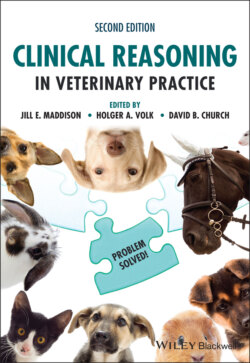Читать книгу Clinical Reasoning in Veterinary Practice - Группа авторов - Страница 35
Define the lesion
ОглавлениеFigure 2.6 Clinical reasoning step‐by‐step: define the lesion.
Once the location of a problem within a body system is determined, usually the next key question is, What is it? You need to identify the pathology – define the lesion. This is now your differential list. It can be helpful to remember the types of pathology that can occur in broad terms – for example, degeneration, anomaly, metabolic, neoplasia, nutritional, infection, inflammation, idiopathic (‘genetic’), trauma, toxic and vascular (DAMNIT‐V).
Which type of pathology is most likely going to depend on the body system or organ involved, the signalment of the patient (species, breed, age, sex etc.), the clinical onset and course of the clinical signs, the geographic location of the patient and what disorders are common in that population.
This assessment can be influenced by whether the patient is in a general clinic or a referral hospital. Common things occur commonly or ‘the hoof beats in the night are much more likely to be due to a horse than a zebra’ (unless you are on safari, of course!). This doesn’t mean that uncommon diagnoses should not be considered (and they will of course be more common in specialist hospitals). It’s just that common disorders usually receive diagnostic priority at the beginning of a clinical investigation in general practice.
Example: the patient has a gastric lesion – is it a tumour, foreign body or ulcer?
This question will require visualisation and/or biopsy to answer, but it would have been a waste of time asking the question until you had arrived at the right location.
Other examples include the following:
Spinal cord pathology identified based on a neurological examination – is it inflammation, infection or a neoplasm?
Haematuria is due to lower urinary tract disease – infection, calculi or neoplasia?
Large bowel diarrhoea – parasites, infection, ulceration, stricture, neoplasia or diet related?
